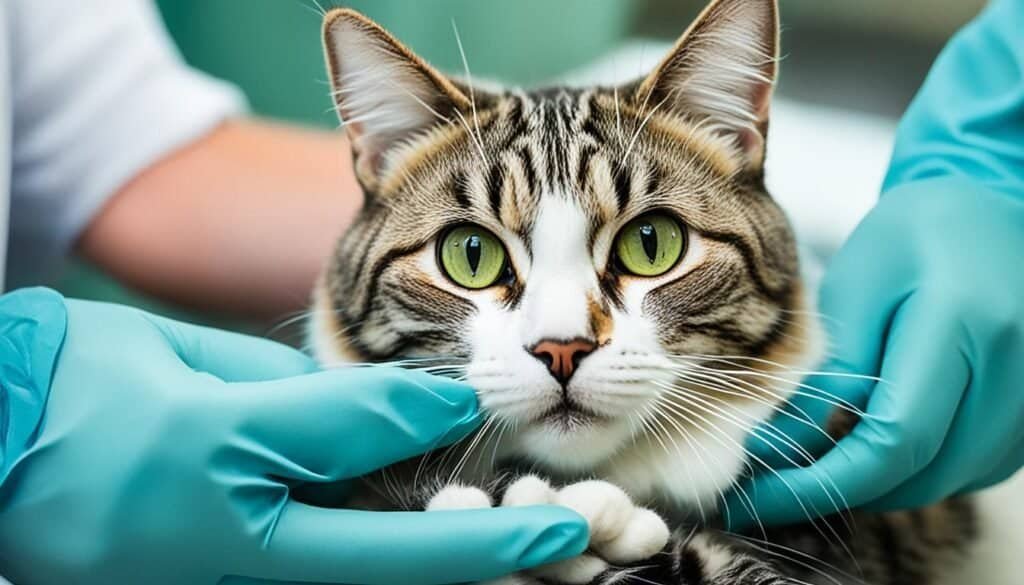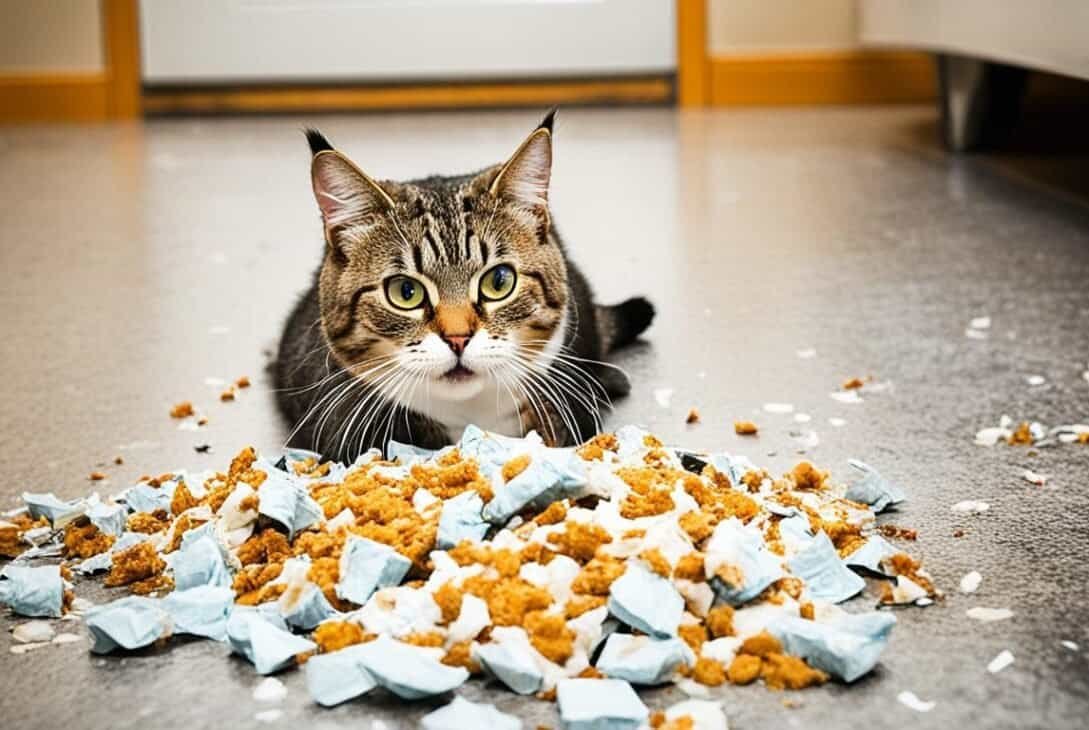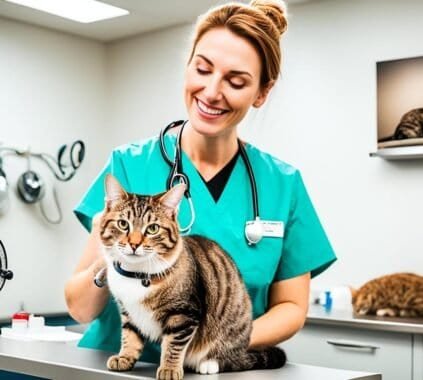In urgent, after-hours situations, it’s crucial to be prepared to provide emergency care for your cat. This article will provide essential tips for handling common urgent health situations, such as vomiting, seizures, and bleeding. Stay informed and ready to take action for your feline friend’s well-being.
Key Takeaways:
- Knowing how to handle common urgent situations can make a significant difference in your cat’s well-being.
- Fast your cat for 24 hours with only water if they are experiencing occasional vomiting.
- Move objects and other pets away to prevent injury if your cat is having a seizure.
- Clean wounds with mild antibacterial soap and apply pressure to stop bleeding.
- Keeping your cat calm, warm, and quiet is crucial in emergencies.
What to Do When Your Cat is Vomiting
If your cat is experiencing occasional stomach upset and isn’t showing other signs of illness, you can take the following steps:
- Fast your cat for 24 hours with only water: This allows their digestive system to rest and recover.
- Gradually introduce small portions of bland foods: Start with boiled chicken and rice, as these are gentle on the stomach. Feed your cat up to four times a day in small portions.
- Monitor your pet closely: Keep an eye on their behavior, appetite, and bathroom habits. Look for any changes or signs of discomfort.
If your cat’s vomiting continues or if they show other signs of illness, it’s important to contact your veterinarian for further guidance and evaluation. They can determine the underlying cause of the vomiting and provide appropriate treatment.
When to Seek First Aid for Pets:
In some cases, vomiting can be a sign of a more serious condition. If your cat exhibits any of the following signs, seek immediate veterinary attention:
- Excessive vomiting
- Loss of appetite
- Lethargy or weakness
- Bloody vomit or diarrhea
- Abdominal pain or discomfort
- Weight loss
Remember, early intervention and treatment can prevent further complications and help your cat recover faster.
| First Aid for Pets: |
|---|
| Step 1: Fast your cat for 24 hours with only water. |
| Step 2: Gradually introduce small portions of bland foods like boiled chicken and rice up to four times a day. |
| If vomiting continues: Contact your veterinarian for further guidance and evaluation. |
“Proper care and timely intervention can help your cat recover from vomiting and prevent further complications.”
Handling Seizures in Cats
Witnessing seizures in your cat can be a terrifying experience. It’s important to handle these situations with care to ensure their safety and provide the necessary first aid. Follow these steps to effectively manage seizures in cats:
- Remove potential dangers: Move objects and other pets away from your seizing cat to prevent any accidental injuries.
- Avoid unnecessary movement: Unless your cat is in immediate danger, avoid moving them during a seizure. Any sudden movements may exacerbate the situation.
- Protect yourself: While cats may not intentionally harm you during a seizure, it’s crucial to protect your hands and fingers to avoid getting bitten unintentionally.
- Record seizure details: Take note of the seizure’s duration, circumstances, and your cat’s behavior afterward. This information will be valuable to your veterinarian in determining the cause and appropriate treatment.
- Keep your cat warm and calm: After the seizure, provide a cozy and comfortable environment for your cat. Keep them warm and avoid any unnecessary stress or stimulation.
- Contact your veterinarian immediately: Seizures can have various underlying causes, and it’s important to consult your veterinarian for further evaluation and guidance.
Remember, seizures can be a symptom of an underlying health condition. Seeking professional veterinary care is essential to ensure your cat receives the necessary treatment and support.
Understanding Cat Seizures
“Seizures in cats can be caused by a variety of factors, including epilepsy, brain tumors, kidney disease, or even certain medications. It’s crucial to work closely with your veterinarian to identify the underlying cause and develop an appropriate treatment plan for your feline companion.” – Dr. Emily Wilson, DVM
During a seizure, your cat may exhibit involuntary movements, muscle twitching, loss of consciousness, or excessive drooling. By taking immediate action and providing the necessary care, you can help manage seizures and ensure the well-being of your beloved pet.
| Common Causes of Seizures in Cats | Symptoms |
|---|---|
| Epilepsy | Recurrent seizures, altered consciousness |
| Brain Tumors | Seizures, changes in behavior |
| Kidney Disease | Seizures, increased thirst and urination |
| Toxin Exposure | Seizures, vomiting, tremors |
| Metabolic Disorders | Seizures, lethargy, poor coordination |
Managing Bleeding in Cats
If your cat is experiencing bleeding, it’s important to take immediate action to ensure their safety and wellbeing. Here are some steps you can follow to manage bleeding in cats:
- Clean the wound: Start by gently cleaning the wound with mild antibacterial soap and warm water. This will help remove any debris or bacteria that may be present.
- Rinse and dry: After cleaning the wound, rinse it thoroughly with clean water. Make sure to dry the area completely to prevent further irritation.
- Apply pressure: Use a clean towel or sterile gauze pad to apply pressure to the bleeding area. This will help promote clotting and slow down the bleeding.
- Cornstarch for bleeding nails: If your cat has a bleeding nail, you can use cornstarch to help stop the bleeding. Dip the bleeding nail into a small dish of cornstarch or apply cornstarch directly to the nail using a clean cotton ball.
- Seek veterinary attention: If the bleeding persists or if the wound is severe, it’s important to contact your veterinarian immediately. They will be able to provide further guidance and determine if additional medical attention is necessary.
Remember, it’s essential to have a calm and steady approach when dealing with bleeding in cats. By following these steps and seeking prompt veterinary care, you can help ensure the best possible outcome for your furry friend.
Initial Steps in Cat Emergency Care
In any cat emergency situation, it is crucial to stay calm and take immediate action. Here are the initial steps to follow for cat emergency care:
- Assess the scene: Ensure everyone’s safety by removing any potential threats or hazards that could harm your cat or anyone else involved.
- Keep the cat warm and calm: Create a quiet and comfortable environment for your cat. Place them in a warm blanket or towel to maintain their body temperature and help reduce stress.
- Minimize movement: Try to limit unnecessary movements that could aggravate any injuries your cat may have sustained. If they are unable to move, avoid the risk of causing further harm by immobilizing them securely.
- Contact the veterinary hospital: Immediately reach out to your nearest veterinary hospital or emergency clinic to inform them of the emergency. They can provide specific instructions and guidance for cat emergency first aid based on your cat’s condition.
- Use a suitable container: To safely transport an injured cat to the veterinary hospital, use a sturdy cardboard box or a cat carrier. This will prevent further injuries and ensure their safety during transportation.
By following these initial steps, you can help stabilize your cat’s condition and provide them with the necessary care before reaching professional veterinary assistance.
Restraint and Transport Tips for Injured Cats
When dealing with injured cats, it’s crucial to handle them with care and ensure their safety during restraint and transport. Follow these tips to provide proper care:
- Use a towel or blanket: When restraining an injured cat, use a towel or blanket to protect yourself and provide a sense of security to the cat.
- Avoid constricting the trachea or airway: Ensure that the towel or blanket is wrapped securely, but not too tight, to prevent any interference with the cat’s breathing or airway.
- Expose the cat’s head: Unless the cat exhibits aggression, it’s best to leave their head exposed during restraint to maintain visibility and minimize stress.
- Consider suspected spinal injury: If there is a possibility of spinal injury, it’s essential to handle the cat with extra care. Placing the injured cat in a large box can provide stability and minimize further damage during transport.

By following these restraint and transport tips, you can ensure the safety of the injured cat and provide them with the necessary care during emergency situations.
Recognizing and Managing Shock
Shock is a life-threatening systemic reaction in cats that can occur due to various causes. It is important to learn how to recognize and manage shock in order to provide immediate care and preserve the cat’s body function.
Recognizing Shock Symptoms in Cats
When a cat is in shock, it exhibits several symptoms that are indicative of a critical condition. These symptoms include:
- Rapid breathing
- Weak pulse
- Pale gums or mucous membranes
- Severe depression
- Cool extremities
By observing these signs, you can quickly identify if your cat is experiencing shock and take immediate action.
First Aid for Shock
When dealing with shock in cats, there are several first aid measures that should be taken:
- Keep the cat quiet and minimize movement to prevent further stress on the body.
- Conserve heat by covering the cat with blankets or towels to help maintain body temperature.
- Ensure a clear airway by gently checking for any obstructions and promptly removing them if present.
- If the cat is having difficulty breathing, assist by providing artificial respiration if you are trained to do so.
- Focus on promoting blood flow to the brain by elevating the cat’s hindquarters slightly if it is safe to do so.
By following these first aid steps, you can help preserve the cat’s body function and potentially improve its chances of recovery.
It is important to note that providing first aid for shock is not a substitute for professional veterinary care. Seeking immediate veterinary assistance is crucial for the cat’s well-being.
Providing Rescue Breathing and CPR for Cats
In emergency situations where a cat is unresponsive or experiencing difficulty breathing or cardiac arrest, it may be necessary to perform rescue breathing and CPR. Follow these steps:
- Clear any airway obstructions: Check for any obstructions in the cat’s mouth or throat. Remove any visible foreign objects.
- Provide rescue breathing: Place the cat on its side and gently extend its head and neck. Seal your lips around the cat’s nostrils and exhale forcefully enough to see the chest rise. Alternatively, you can use a makeshift device like a small mask or plastic bag to provide the rescue breaths. Give two breaths, watching for chest rise and fall.
- Perform chest compressions: If there is no heartbeat, place your hands on the cat’s chest, just behind the elbows. Compress the chest using quick, firm pressure. Perform compressions at a rate of 100-120 compressions per minute.
- Continue rescue breathing and chest compressions: Alternate between rescue breaths and chest compressions in a ratio of 2 breaths to 30 compressions. Continue this cycle until the cat starts to breathe on its own or until veterinary help arrives.
Even if the cat appears to recover fully after rescue breathing and CPR, it is essential to seek immediate veterinary examination. The veterinarian can assess the cat’s airway, breathing, and cardiac function, ensuring there are no underlying issues or complications. Seeking veterinary care after CPR is crucial for the cat’s overall well-being and recovery.
CPR for Cats – Recommended Actions
| Steps | Actions |
|---|---|
| 1 | Clear any airway obstructions |
| 2 | Provide rescue breathing, either directly or using a makeshift device |
| 3 | Perform chest compressions |
| 4 | Continue cycle of rescue breathing and chest compressions until help arrives or the cat begins breathing on its own |
Note: CPR should only be performed by individuals trained in this life-saving technique. It is always recommended to seek immediate veterinary assistance in emergency situations.
Recognizing and Responding to Common Emergencies
In the event of an emergency, it’s crucial to be able to recognize the signs and respond appropriately to ensure your cat receives the immediate care it needs. Here are some common cat emergencies and how to handle them:
Allergic Reactions in Cats
Cats can have allergic reactions to various substances, including certain foods, medications, or environmental factors. If you notice your cat experiencing symptoms such as swelling, itching, hives, or difficulty breathing, it could be an allergic reaction. Contact your veterinarian immediately for guidance on the next steps.
Bleeding Severity
Accidents happen, and cats can sometimes experience bleeding. It’s important to assess the severity of the bleeding. If the bleeding is severe or cannot be stopped with gentle pressure, immediate veterinary attention is necessary. Use clean towels or bandages to apply pressure to the wound while transporting your cat to the veterinarian.
Difficulty Breathing in Cats
Difficulty breathing is a serious emergency. If your cat is struggling to breathe, has rapid or shallow breaths, or makes abnormal noises while breathing, it could indicate a respiratory problem. Ensure your cat has a clear airway, and contact your veterinarian immediately for further instructions.
Injuries in Cats
Cats can sustain injuries from falls, fights, or accidents. If your cat appears to be in pain, has visible wounds, or is unable to walk, it’s important to handle them with care. Use a towel or blanket to gently restrain the injured area and transport your cat to the veterinarian for evaluation and treatment.
Poisoning in Cats
If you suspect your cat has ingested something toxic, such as certain plants, household chemicals, or human medications, contact your veterinarian immediately. Look out for symptoms like vomiting, diarrhea, drooling, seizures, or weakness. Avoid inducing vomiting or administering any home remedies without professional guidance.
Heat Stroke in Cats
Cats are susceptible to heat stroke, especially during hot weather. If your cat is panting excessively, has difficulty breathing, seems lethargic, or collapses, it could be experiencing heat stroke. Move your cat to a cool, shaded area, provide water to drink, and contact your veterinarian for further instructions.
“In cat emergencies, recognizing the signs and responding promptly can save your cat’s life. Don’t hesitate to seek professional veterinary care – it’s always better to be safe than sorry.”
| Emergency | Signs | Action |
|---|---|---|
| Allergic Reactions | Swelling, itching, hives, difficulty breathing | Contact veterinarian immediately |
| Bleeding | Severe bleeding, bleeding that can’t be stopped | Apply gentle pressure, transport to veterinarian |
| Difficulty Breathing | Rapid or shallow breaths, abnormal breathing noises | Ensure clear airway, contact veterinarian immediately |
| Injuries | Pain, visible wounds, inability to walk | Gently restrain, transport to veterinarian |
| Poisoning | Vomiting, diarrhea, drooling, seizures, weakness | Contact veterinarian immediately, avoid home remedies |
| Heat Stroke | Excessive panting, difficulty breathing, lethargy, collapse | Move to cool, shaded area, provide water, contact veterinarian |
Remember, it’s crucial to contact your veterinarian immediately if your cat exhibits any signs of a common emergency. They will provide guidance on the next steps and the need for emergency care. Your swift action and attention can greatly contribute to your cat’s recovery and overall well-being.
Importance of Seeking Immediate Veterinary Care
When it comes to your cat’s health, any signs of distress should be taken seriously. Cats are known to hide their pain and discomfort, making it crucial to seek immediate veterinary care in emergency situations. Delaying treatment can have serious consequences and may worsen your cat’s condition.
If you notice any of the following signs in your cat, it is important to act promptly:
- Dehydration
- Unusual gum color
- Irregular heart rate or rhythm
- Unresponsiveness
- Other concerning symptoms
These signs can indicate a severe emergency requiring immediate attention. Remember, your cat’s well-being depends on timely intervention and proper medical care. Don’t hesitate to contact your veterinarian or an emergency clinic to discuss your cat’s symptoms and seek professional advice.
After an emergency, it is also essential to schedule a thorough veterinary examination. Even if your cat appears to have recovered, there may be underlying issues or hidden pain that only a professional examination can identify.
“The sooner you seek veterinary care, the better the chances of a successful outcome for your cat’s health and well-being.”
By prioritizing immediate veterinary care and follow-up examinations, you can ensure the best possible outcome for your beloved feline companion.
Taking Quick Action Saves Lives
When it comes to emergencies, time is of the essence. Taking quick action can help save your cat’s life and prevent further complications. Delaying treatment increases the risks and can lead to more severe health issues in your cat.
Always trust your instincts as a responsible pet owner. If you suspect something is wrong with your cat, it’s better to err on the side of caution and seek professional help.
Preventing Invisible Dangers
Cats are masters at hiding their pain. They may continue to groom themselves, eat, and carry out their routine activities even when they are suffering. By seeking immediate veterinary care, you can prevent the invisible dangers and ensure your cat receives the appropriate treatment.
Remember, cats rely on you to advocate for their health and well-being. Regular check-ups and immediate care in emergencies are essential for providing the best possible quality of life for your feline friend.
Finding Emergency Veterinary Care for Cats
In case of emergencies outside regular veterinary clinic hours, it’s important to know where to find emergency veterinary care for your cat. Prompt action can make all the difference in your pet’s well-being. Here’s what you need to know:
Contact Your Regular Veterinarian
Start by reaching out to your regular veterinarian and inquire about their after-hours clinic. They may have arrangements to provide emergency care or can direct you to a trusted emergency clinic nearby.
Search for Nearby Emergency Clinics
If your regular veterinarian does not have after-hours services, it’s essential to locate nearby emergency clinics. Search online or consult your local directory for emergency veterinary clinics in your area. Look for ones that specialize in providing urgent care for animals.
Call Ahead and Provide Details
Before rushing your cat to an emergency clinic, call ahead to ensure they can accommodate your cat’s specific emergency. Be prepared to provide all relevant details about your cat’s condition, including symptoms, duration, and any known medical conditions. This information will help the veterinarians assess the situation and provide appropriate care.
Remember, time is of the essence in emergencies. Having the contact information for emergency clinics readily available can expedite the care your cat needs and ensure a faster response.

Conclusion
When it comes to cat emergency care, being prepared and taking prompt action is essential. Your feline friend’s well-being depends on your ability to handle common urgent situations and know when to seek professional veterinary help.
Remember to stay calm and assess the situation. It’s important to contact your veterinarian or an emergency clinic for guidance. With proper care and attention, you can ensure the best possible outcome for your cat in times of emergency.
By following the tips provided in this article, you can be prepared to handle vomiting, seizures, bleeding, and other emergency situations. Always prioritize your cat’s safety and well-being by seeking immediate veterinary care when necessary.
FAQ
What should I do if my cat is vomiting?
How should I handle seizures in my cat?
What should I do if my cat is bleeding?
What are the initial steps in cat emergency care?
How should I restrain and transport an injured cat?
How can I recognize and manage shock in my cat?
How do I provide rescue breathing and CPR for cats?
What are some common cat emergencies that require prompt attention?
Why is it important to seek immediate veterinary care for my cat in an emergency?
Where can I find emergency veterinary care for my cat?
Last modified: February 19, 2024














[…] As cats age, they may start to exhibit changes in their behavior. It’s important for pet owners to be aware of these changes and provide the necessary support to ensure the emotional well-being of their senior cats. Here are some tips for providing behavioral and mental care for elderly cats: […]
[…] a wide range of cat food options made with real meat as the primary ingredient. Their formulas are carefully crafted to provide a complete and balanced diet for cats of all life […]
[…] ensure optimal dental care for your cat, regular toothbrushing is essential. Brushing your cat’s teeth helps prevent periodontal […]
[…] are susceptible to various illnesses that can affect their well-being. Understanding these common cat illnesses is essential for cat owners in order to provide the necessary care and […]
[…] gaps in their immunity. Regular boosters also give veterinarians an opportunity to assess your cat’s overall health and address any emerging issues […]